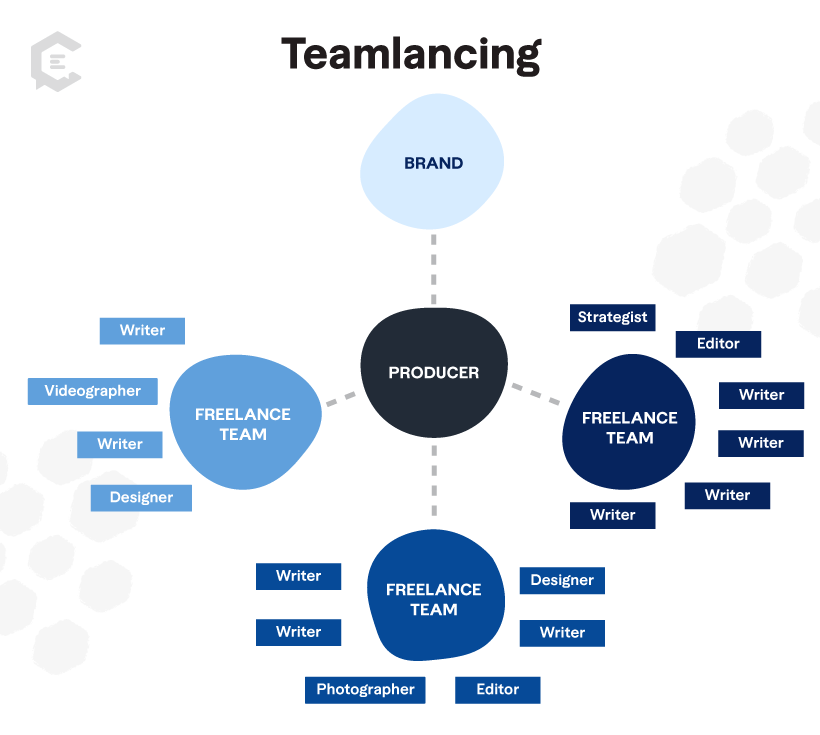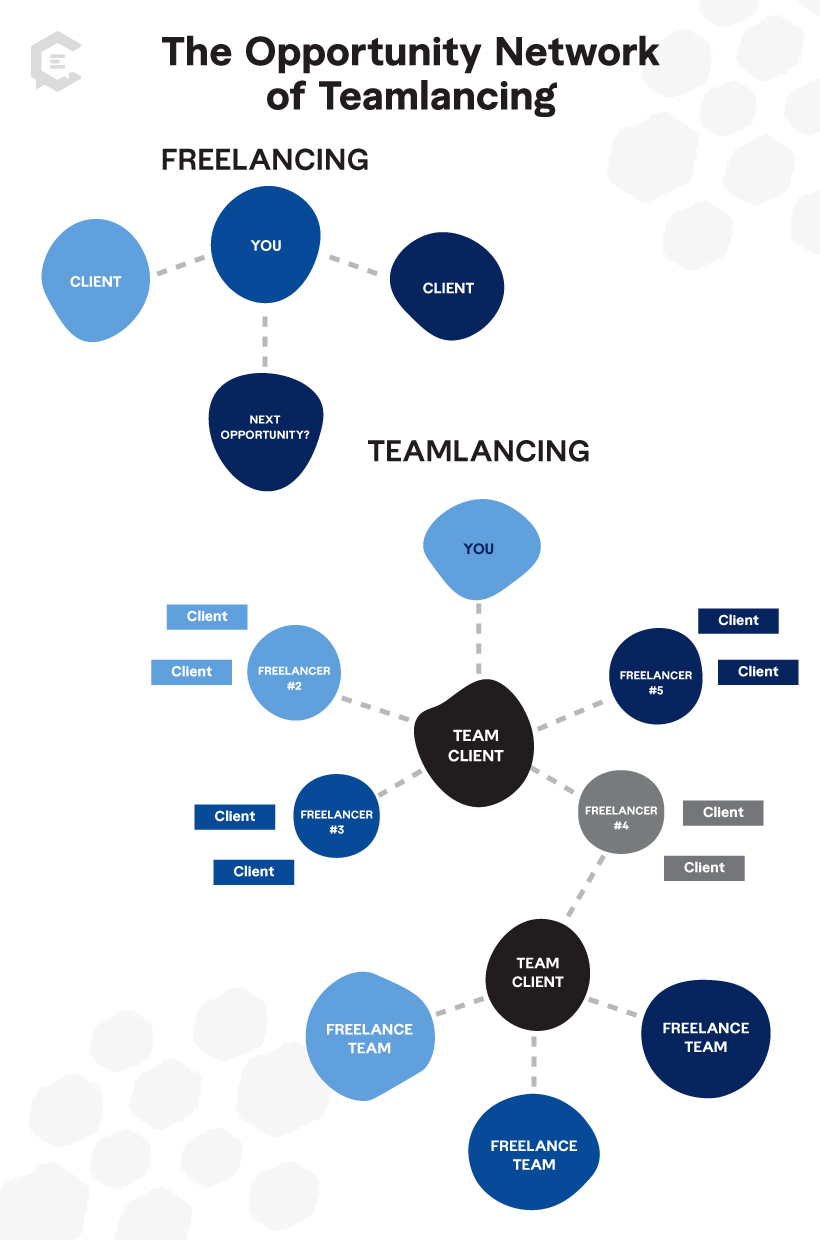What is teamlancing? Teamlancing is the practice of collaborating with a networked team (or networked teams) of freelancers to achieve a common goal, whether for a client or as a remote extension of a branded entity.
Prefer to read a PDF? Download our eBook version of this post.
Hollywood might always romanticize the writer — the classic freelancer — as an upstart or ingénue who clackety-clacks on a Royal Classic by night and scuffles with a boisterous editor by day, often with swirling montages of headlines or magazines in between. And it’s no surprise…
From a narrative standpoint the relationship between a writer and editor has always been easy fodder for tension, drama and growth. The one-to-one push and pull. The pinballing dreamer on one side, and the straight-shooting gruffin** on the other. The audience gets it.
For decades, this narrative model has reflected what many people have thought of freelancing: It’s just a hobby or an Oprah-style exercise in self-actualization. Just a “dream thing” or a fleeting tête-à-tête. And for freelancers, many still might only think about the next project, the next outlet, the next client — one by one by one, hustling all on their lonesome — without realizing that the narrative has been changing.
Today, freelancing is shifting from a solo hobby to a collaborative enterprise, with freelancers often working with a wider cast of characters than just a solitary gruffin haunted by years of word-slaughter. In the new age of collaboration, teams are the thing. And they have become such the thing they could lead the next generation of Carrie Bradshaws to wonder, “Is teamlancing the new freelancing?”
So let’s explore. Find three main sections in this post:
- So what is teamlancing?
- What does teamlancing mean for freelancers?
- What does teamlancing mean for marketers?
[**Note: In case you were wondering what a gruffin is, you’re not crazy. It’s an original word of my own creation, a portmanteau of gruff and muffin. Gruffin — (GRUF-in): 1. (n.) an outwardly gruff and stern individual who actually is quite a softy; 2. (n.) a burnt muffin that curiously still has a soft, moist and edible inside; 3. (adj.) part rough and part soft in composition.]
So what is teamlancing?
Although the portmanteau of team and freelancing has been around for years (with various uses), the term teamlancing has taken on new meaning in the gig economy, as technology has made remote collaboration easier than ever, as the return on investment (ROI) of flexible teams has risen, and as more and more people have been seeking out multiple income streams on their own.
At ClearVoice, we developed our platform to anticipate this future of freelancing for content creators and marketers. And the future is already here! So let me share our definition for this unstoppable trend:
What is teamlancing? Teamlancing is the practice of collaborating with a networked team (or networked teams) of freelancers to achieve a common goal, whether for a client or as a remote extension of a branded entity.
- Individual freelancers can teamlance simultaneously on multiple teams, each with different numbers of freelancers or combinations of freelance roles, for any number of clients — or manage other freelancers themselves.
- Brands can turn to teamlancing to maximize the flexibility of their operations with self-managing creative resources that are specialized, right-sized and timed to their changing needs, whether project-based or for the long term.
Here’s an example visualization of a brand using teamlancing as a way to scale up their content creation without dramatically scaling up their direct effort. If you were an enterprise brand, you could easily tap into specialized freelance teams for various verticals or campaigns.

Fulfill the creative economies of scale.
On the most basic level, the shift to teamlancing is all about math and the economies of scale. On one side, how can you grow your freelance business as a creative? On the other side, as a brand, how can you save time and money while tackling the highly variable demands of creative projects?
- For freelancers, working on multiple teams with other freelancers increases income stability via networked access to new, possibly more attractive opportunities.
- For brands, working with networked freelance teams (who can operate as self-managing units) offers the ultimate flexibility of scale without the costs of one-on-one talent procurement and long-term management.
Look to the roots of teamlancing in Hollywood.
With all of its studios, associations, guilds and unions, Hollywood arguably invented teamlancing. So if you’re familiar with how the entertainment industry produces movies and television shows, you already have an excellent model for understanding the concept.
Depending on the project, Hollywood producers have to hire directors, actors, cinematographers, production designers, costume designers, lighting directors, camera operators, sound engineers, editors, visual effects artists, makeup artists, etc. — the list of department teams and roles goes on and on. And it’s not uncommon for the number of credits on a major film to exceed 500.
So on a fundamental level, Hollywood cannot exist without flexible pools of talent — whether based on location, skill set, or role — because the industry is highly project-based, widely diverse in scale, sometimes ego-driven, and often fickle. Sound familiar, dear marketers?
The logistical variables are endless, to mention a few:
- Creative needs can vary widely, and contingencies abound.
- Each project requires a unique combination of talent and resources.
- Multiple creative disciplines require self-management and specialized leadership.
- Schedules can demand simultaneous shoots and production tracks.
- Projects can be greenlit, then shelved, then revived or rebooted.
Hollywood is a stopwatch tracking multiple runners on multiple tracks in multiple universes. Stop and start. Stop and start. It relies on a masterful Venn diagram of teams to win, from the massive corporate level down to the indie upstart.
And the connections are everywhere in unspoken cross-sections of teams as well. For instance, it’s not uncommon for associates to work on multiple projects at the same time, or for actors to work with some colleagues more than others. Think about the six degrees of Kevin Bacon, or recurrent movies with alumni from ‘SNL’ or Second City.
Teamlancing in some form or other is pervasive in entertainment, whether due to the nature of the craft, with its mind-boggling production logistics, or via industry unions and cliques of talent. And you’d be remiss to not recognize that a system that once was predominantly in Hollywood is now a springboard for the future of freelancing and content marketing everywhere.
So embrace the new dimensions of flexible, networked freelance teams as you approach content collaboration or marketing in general.
What does teamlancing mean for freelancers?
During my career I have worked with hundreds of freelance creatives and have managed thousands upon thousands of assignments. In my first real job after college, in the aughts, I plunged into the role of an entertainment editor, directing teams of freelance writers and photographers in markets scattered across the country (Phoenix, Memphis, and Charlotte to be exact) — and I managed them all remotely from an office in Santa Monica, California.
In quick order I was promoted to managing the behemoth Los Angeles/Orange County market, with 60+ simultaneous freelancers at its peak, along with an in-house team of contractors. Unfortunately, this was long before the beauty of ClearVoice or Fiverr, and we relied on email subject line formats and FileMaker Pro (which seems so ancient now) to make the collaboration process remotely feasible. But little did we realize at the time — we were all teamlancing.
As was the daily course of the creative process, editors reached out to writers, writers reached out to photographers, or freelancers collaborated with each other on special features. Teams of freelancers would rally around the successes of their respective beats or markets. It was all teams all the time.
And in the process, many of our freelancers, although scattered across wide geographies and with backgrounds just as varied, developed relationships and bonds with one another, became lifelong friends and colleagues — and naturally evolved into social networks of support for years of personal growth.
After all this time, one key difference between those who succeeded and those who floundered stood out most: None of our best freelancers treated the work like “just a gig.”
And neither should you. Because…
I can tell you with zero doubt… The most important thing for you to succeed as a freelancer is to always act like you are part of a team.
Whether your client treats you the same as an in-house team member, or not, is irrelevant. Whether you’re working on a solo project or are an anonymous cog in a massive project — it doesn’t matter. What matters most in the long run is what you bring yourself: your work ethic, your professionalism, your talent and, above all, your camaraderie.
Never forget the camaraderie, especially when creating content. Collaboration is a conversation, not a transaction. Over time, your social connections with other freelancers, whether individually or across teams, will help you grow.
Even if you’re an introvert, and if it might be hard to connect with others, your access to more rewarding work depends on building new relationships. Consider the exponential access to opportunities through working with freelance teams and with the team mindset as your guiding principle.

What are the benefits of teamlancing for freelancers?
Working with teams is just easier. If you’re still going solo, reach out and create an informal freelance group of your own. Or, if you’re working with a brand, make an effort to connect with freelance colleagues who might also be creating in tandem. And, most importantly, never burn bridges or treat any opportunity — or any person — as expendable. You have so much more to gain by following the Golden Rule.
So let’s wrap up the benefits of teamlancing for freelancers:
- Find more work with established clients and brands.
- Improve your chances for recurring work instead of one-off assignments.
- Expand your network for more income opportunities.
- Make stronger connections with colleagues.
- Keep in touch with industry and content trends.
- Improve your skills via on-project co-learning with peers.
- Reduce chances of payment issues by working with vetted clients.
- Get support from fellow freelancers when client issues arise.
What does teamlancing mean for marketers?
As previously noted, teamlancing can help brands right-size their creative resources to help them create content faster without the added time and costs of hiring or managing in-house.
While hiring full-time creative teams can take several months, teamlancing can access a similar scale of talent in days, and without the long-term risks or overhead. And unlike hiring individual freelancers and having to manage each on an one-by-one basis, the new teamlancing model relies more on freelancers to collaborate and self-manage projects just the same as an in-house team would.
For instance, a freelance producer can hire and manage writers, designers, or editors, and be the primary point-of-contact with a brand marketer — in effect becoming a freelance team manager (i.e., like a department head on a film shoot), dramatically reducing the time involvement for the brand marketer. Or, a freelance producer can manage multiple teams, if your content requires segmented expertise or verticals.
If your brand’s content strategy demands flexibility at scale, teamlancing is the perfect fit.
- Need 10 writers, a designer, and copy editor to fuel a health channel? Easy.
- Require two managing editors, 30 writers, and three designers to turn your brick-and-mortar chain into a digital enterprise? Done, done, and done.
- Want a journalist, a videographer, and motion graphics designer to produce a series of testimonial videos? Your teamlancing producer can handle it all.
What are the benefits of teamlancing for brands?
If your brand is considering outsourcing your content production, you should seek out an agency or all-in-one content provider that embraces the teamlancing solution like ClearVoice.
So let’s wrap up the benefits of teamlancing for brands:
- Assemble teams with specialized skills suited for specific projects.
- Hire self-managing teams instead of managing individual contributors.
- Scale teams up or down, as needed, to right-size resources quickly.
- Avoid the overhead costs of in-house human resources management.
- Improve content quality via collective team pressure and collaboration.
- Adapt to business demands more readily with access to global talent.
- Experiment and innovate more quickly with greater creative mindshare.
- Work with freelancers who have vested interests in learning your brand voice and guidelines.
Teamlancing vs. outsourcing
Right now you might be thinking, “The sky is blue. Baby Yoda could save the world. Brewing a cappuccino with Hawaiian Punch is not a culinary win. Not a win. But can you tell me something I don’t know? It sounds like teamlancing is plain ol’ outsourcing to me.”
Actually, it is a form of outsourcing — but on a higher level. Although both teamlancing and outsourcing are similar in the manner in which a company uses an outside vendor to perform a specific service or function, teamlancing involves creative input and collaboration, not just executing a rote function.
Here are three general aspects of each:
Outsourcing usually…
- Fulfills a specific role at scale.
- Involves a single third party.
- Requires little or no creative collaboration.
Teamlancing usually…
- Fulfills a combination of varied roles at scale.
- Involves multiple third parties (i.e., freelancers and/or self-managing freelance teams).
- Requires creative collaboration with and among third parties.
To go back to the Hollywood analogy, hiring a spectrum of skilled freelance teams to create a feature film is quite different than outsourcing a customer service team that follows procedural scripts at a call center.
Teamlancing requires individuals to contribute creatively and collaborate with others in multiple disciplines, while outsourcing requires individuals to only follow a rote task they are given, without creative input or collaborating with others. One is collaboration, while the other is more like automation.
So you can use outsourcing in the general sense to describe teamlancing as a type of outsourcing, but teamlancing is far more than just fulfilling a rote function. It’s a multi-level, varied set of creative functions and roles collectively managed via remote, networked collaborators who have a vested interest in achieving together — with the same gusto as an in-house team.
Teamlancing encourages more professionalism, better work, and more accountability because the freelancers can rely on the social and creative support of a team, instead of working in an isolated or anonymous manner without group feedback or pressure.
Turn to ClearVoice as the teamlancing solution for:
- Major projects — Score immediate wins with major content projects and core assets.
- Campaigns — Gain momentum with strategic initiatives for specific time frames and KPIs.
- Long-term growth — Build your brand with consistent content to spur long-term returns.
- Enterprise scale — Accelerate your business with high-volume content for ambitious growth.










